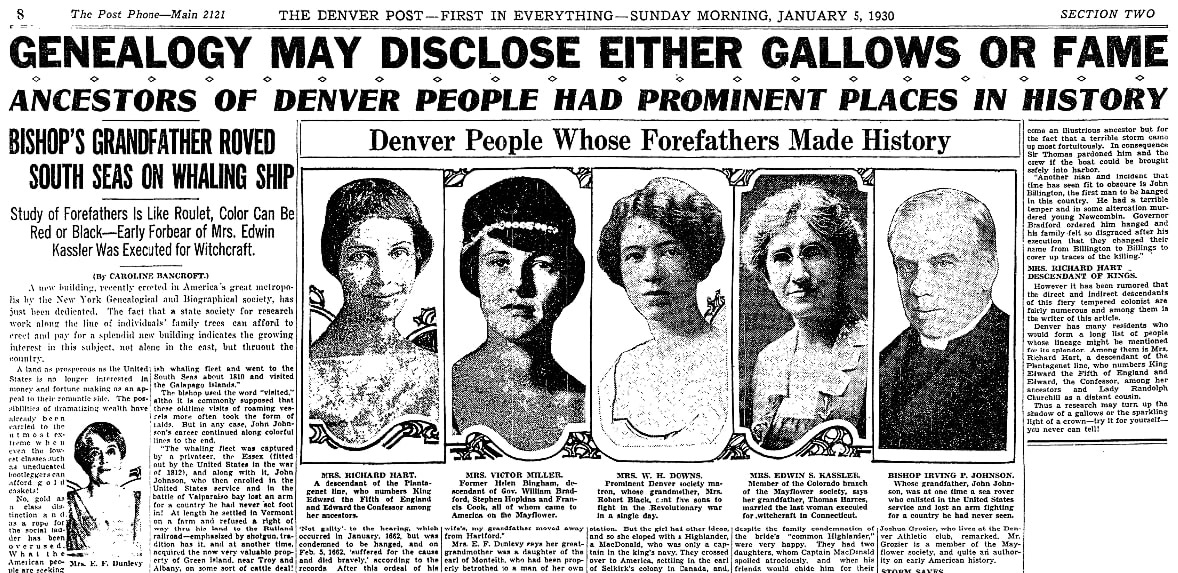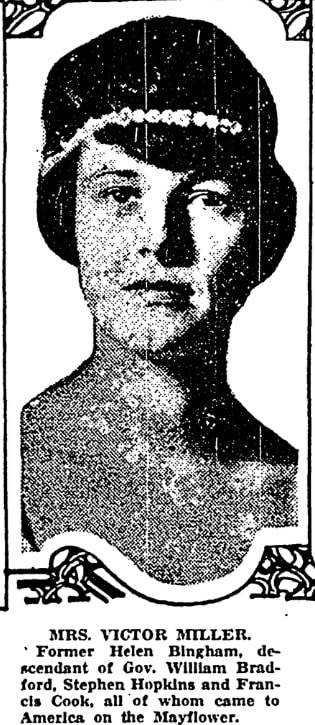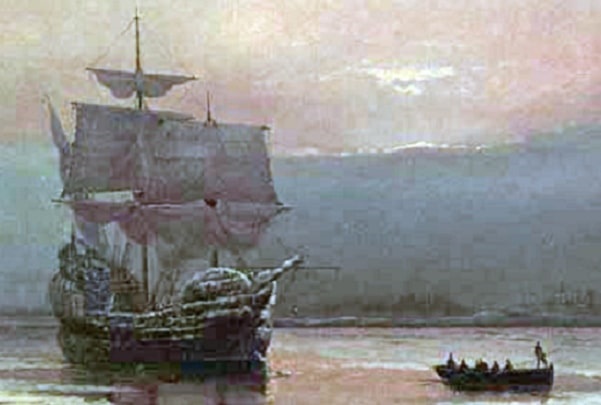Introduction: In this article, Melissa Davenport Berry continues her series profiling descendants of the Mayflower settlers, focusing on descendants in Colorado. Melissa is a genealogist who has a blog, AnceStory Archives, and a Facebook group, New England Family Genealogy and History.
Today I continue my series on “Mayflower Descendants: Who’s Who,” using a 1930 Denver Post newspaper article by Caroline Bancroft. Among the Denver citizens to be included in Bancroft’s feature were Mayflower descendants.

The article noted that forefather digging is like roulette and may disclose gallows or fame. Bancroft likes to use little surprise finds as humorous anecdotes, and appreciates that forbears are full of little jokes. She advises those who delve into genealogy research to keep a sense of humor.
Bancroft notes that with the growing popularity of genealogy, “the butcher and baker and candlestick maker want eminent ancestors” and social standing, but she warns:
“But if it [genealogy] is to be conducted on strictly authentic lines, there will be many a surprise hidden in the files of its records, waiting to pounce out upon the unsuspecting patron. Ancestors have a way of not running true to a nice, genteel pattern, and the black sheep of a really illustrious line have an uncomfortable habit of turning out to be direct grandfathers rather than members who could be pointed to with pride.”
Helen Ludlow Bingham
One of the Mayflower descendants profiled by Bancroft was the society maiden Helen Ludlow Bingham, who was descended from Governor William Bradford, Stephen Hopkins, and Francis Cooke. She was the daughter of Homer William and Adelaide (nee Ludlow) Bingham and married Victor Arthur Miller, son of Arthur Scott and Emma (nee Combs) Miller. She married 2nd Benjamin Franklin Salzer.

Helen stated:
“I found two of my ancestors who exhibited particularly human traits. One of them was John Warren, who lived in Watertown, [Massachusetts,] and in 1650 was fined 20 shillings for an offence against the laws of public baptism. He was repeatedly had up for failing to attend public worship and made himself so unpopular in the community that when a warrant was issued some time later to search his premises for Quakers, they wrote it very disrespectfully ‘the house of Old Warren.’
“The other ancestor who entertained me was the one of Lafayette’s men, Loring Thompson, who was knocked down by the wind of a cannonball and picked up for dead. He turned out to be only stunned, and was so pleased at this good luck that he immediately set out to write his memoirs!”
Helen served as deputy governor of the Colorado Mayflower Society, and after her death her daughter, Marcella Miller Meyer, created the Helen Bingham Salzer Fund for the New England Historical and Genealogical Society, Boston, in honor of her mother.
Leila Buchtel
Another Mayflower descendant was Mrs. Edwin Kassler (born Leila Buchtel), a descendant from Governor William Bradford. She was the daughter of Dr. William Harmon and Helen Maria (nee Barnum) Buchtel, and wife of Edwin Stebbins Kassler. She married 2nd Fred Chamberlain. Her mother was the daughter of the famous Phineas Taylor “P. T.’ Barnum and his wife Charity Hallet. Mrs. Kessler was elected governor of the Colorado Mayflower Society in 1925.
Leila said her ancestor Thomas Barnes had a wife Mary who was the last women executed for witchcraft in Connecticut. She stated:
“I have a letter describing the trial with copies of the documents used. She [Mary] pleaded ‘Not guilty’ to the hearing, which occurred in January 1662, but was condemned to be hanged, and on Feb. 5, 1662 ‘suffered for the cause and died bravely,’ according to the records.”
Joshua Grozier
Mr. Joshua Grozier was a member of the Mayflower Society and an authority on early American history. His Mayflower ancestor was Stephen Hopkins.
Joshua stated:
“It is interesting to see how the passage of time obscures much that is wished to be forgotten.
“For instance, the [Stephen] Hopkins who crossed on the Mayflower and was a member of the Plymouth colony, is the same [Stephen] Hopkins who earlier, at the second expedition to Jamestown, started a mutiny of the whole crew against Sir Thomas Gates. He would most certainly have been executed and never lived to become an illustrious ancestor but for the fact that a terrible storm came up most fortuitously. In consequence Sir Thomas pardoned him and the crew if the boat could be brought safely into harbor.
“Another man and incident that time has seen fit to obscure is John Billington, the first man to be hanged in this country. He had a terrible temper, and in some altercation murdered young Newcombin. Governor Bradford ordered him hanged, and his family felt so disgraced after his execution that they changed their name from Billington to Billings to cover up traces of the killing.”
Stay tuned for more on Mayflower descendants!
Note: An online collection of newspapers, such as GenealogyBank’s Historical Newspaper Archives, is not only a great way to learn about the lives of your ancestors – the old newspaper articles also help you understand American history and the times your ancestors lived in, and the news they talked about and read in their local papers. Do you have a connection all the way back to the Mayflower Pilgrims?
Related Articles:
- Mayflower Descendants: Who’s Who, Part I
- Mayflower Descendants: Who’s Who, Part II
- Mayflower Descendants: Who’s Who, Part III
- Mayflower Descendants: Who’s Who, Part IV
- Mayflower Descendants: Who’s Who, Part V
- Mayflower Descendants: Who’s Who, Part VI
- Mayflower Descendants: Who’s Who, Part VII
- Mayflower Descendants: Who’s Who, Part VII (conclusion)
